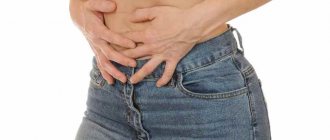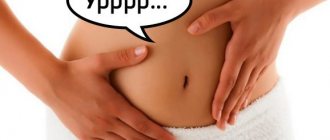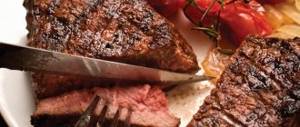- Causes and nature of pain
- Diagnostics and therapy
Such a symptom as sharp pain in the lower abdomen in women, without exaggeration, is familiar to many women. But often, the pain is underestimated. When pain occurs, most people take painkillers. Few people think about visiting a doctor.
And in vain, because in fact, pain in the lower abdomen, in the side on the right or left is dangerous, especially if they appear too often. “Downloading” pain for a while does not mean curing the disease. Of course, taking painkillers is important in this case. But pain pills are far from the only drug your body needs in this case.
Therapy for pain, or more precisely for the disease that provoked its appearance, must be comprehensive. Only a qualified specialist can prescribe a particular medication and only after all the necessary research has been carried out and the root cause of the pain has been clarified. Ignoring the appearance of pain and inappropriate use of medications is fraught with disastrous consequences.
Pain in the lower abdomen is a fairly common nonspecific symptom that signals the presence of pathologies of the pelvic organs, genitourinary system and intestines. Sharp pain in the lower abdomen in women is not the only type of pain.
The pain may be:
- acute;
- paroxysmal;
- pulsating;
- blunt;
- constant;
- periodic;
- cutting;
- piercing;
- aching;
- pulling.
In addition, when complaining of pain, the doctor clarifies not only its location and type, but also the presence or absence of accompanying symptoms. In addition, the connection with the menstrual cycle, ovulation or pregnancy is clarified.
This is how the specialist will be able to find out whether the pain is dangerous for the life of the woman or the fetus (if the woman is pregnant), and also whether it is fraught with the threat of termination of pregnancy. Now let's talk about the types of pain in a woman's lower abdomen, including sharp ones. Each type of pain can signal damage to a specific organ and the development of a specific disease.
- The occurrence of dull pain, accompanied by bleeding that has no connection with menstruation, often signals the presence of inflammation in the female reproductive system.
- The appearance of pain, accompanied by an increase in temperature and discharge from the genital tract, may signal an infectious pathology of the pelvic organs.
- Pain in the lower abdomen in combination with difficulty urinating may indicate an illness of the urinary system.
- The occurrence of pain accompanied by symptoms such as nausea, vomiting, loss of appetite is a sign of damage to the gastrointestinal tract.
- The appearance of intense increasing or subsiding pain in the lower right is one of the signs of appendicitis.
- Periodic and prolonged pain indicates an acute or chronic form of the existing disease.
- Sharp pain in a woman’s lower abdomen may be evidence of an acute intestinal infection, poisoning, intestinal obstruction, or appendicitis.
- The appearance of cutting, acute, unbearable pain in the right side may indicate acute cholecystitis or hepatic colic.
- A nagging or dull pain in the lower abdomen is one of the signs of an ectopic pregnancy, an inflammatory process in the uterus, appendages and fallopian tubes (adnexitis), and bladder.
Soreness can appear for a variety of reasons and as a result of a variety of ailments, and not only gynecological ones. That is why, without knowing the cause, you should not take any measures without a doctor. If you attribute pain in the lower abdomen due to appendicitis to periodic pain during menstruation, believe me, everything can end in disaster. That is why, if you have abdominal pain, do not hesitate to contact a specialist.
As already mentioned, pain can be caused by a variety of ailments, and not only the female reproductive system. If we talk about gynecological pathologies, then pain is not their only manifestation. Often, with gynecological diseases, in addition to pain in the lower abdomen, there are complaints about the appearance of discharge, menstrual irregularities, frequent urination, itching in the perineum, and malaise.
Often women suffering from diseases of the reproductive system cannot become pregnant for a long time. So, pain in the lower abdomen can be a sign of the following pathologies: adhesive disease, endometriosis, cysts, neoplasms, ectopic pregnancy, vaginitis, ovulatory syndrome, salpingitis, adnexitis.
Pain in the lower abdomen may be evidence of uterine reproductive disorders:
- incorrectly selected intrauterine device;
- adenomyosis;
- endometritis;
- uterine fibroids;
- cervicitis;
- polyps;
- dysmenorrhea;
- stenosis of the cervical canal.
In this case, the pain may be accompanied by an increase in temperature, bleeding, cloudy vaginal discharge with an unpleasant odor, burning during urination, pain during sexual intercourse, nausea, malaise, and loss of appetite.
Sharp pain in the lower abdomen can be a sign of urological disorders, in particular: cystitis, neoplasms in the bladder, urolithiasis.
In this case, there may be complaints of nausea, vomiting, fever, blood in the urine, malaise, cloudy urine, pain during urination.
Often, sharp pain in the lower abdomen is caused by intestinal disorders: ulcerative colitis, intestinal obstruction, colon polyps, colon cancer, appendicitis, chronic constipation, irritable bowel syndrome.
If the pain is caused by ulcerative colitis, then in addition to pain there are complaints of loose stools with mucus and blood, loss of appetite, increased temperature, and weight loss. If pain occurs due to Crohn's disease, it is often accompanied by malaise, fever, constipation, and flatulence.
With chronic constipation, patients complain not only of pain in the lower abdomen, but also of flatulence, malaise, weakness, nausea, vomiting, and increased gas formation. If the cause of pain is cancer, the pain is accompanied by upset stool, bleeding, pallor, weight loss, and malaise.
What can cause abdominal pain?
A symptom such as abdominal pain accompanies many diseases and life-threatening conditions. Unpleasant sensations and pain worsen his well-being, reducing his performance. Therefore, it is necessary to quickly determine the causes of colic, for which it is necessary to seek medical help.
Often, when pain appears in the abdominal area, to eliminate it, a person takes painkillers or antispasmodics. Women especially often do this, attributing unpleasant symptoms to the course of the menstrual cycle. However, we must remember that, in addition to the physiological causes of pain, there are also pathological development factors that pose a danger to life and health.
Physiological reasons
Physiological causes of cutting pain in the abdomen include:
- Stress, psychological stress, excessive emotions
- Physical overload.
- Binge eating.
- Drinking food with water.
- Abuse of alcoholic beverages or fatty, salty foods.
- Lots of plant fiber in the diet.
- Incorrect use of medications.
- Dysbacteriosis.
- Menstruation.
Pathological preconditions
There are many pathological causes of pain in the abdomen, some of which require medical intervention. This symptom can manifest itself in diseases of the gallbladder, kidneys, liver, stomach, pancreas and other gastrointestinal organs. For example:
- Acute appendicitis. It develops very quickly. One of the first symptoms of the disease is sudden severe pain in the abdominal area, often most pronounced in the lower right side. Along with attacks of pain, the following may be observed: vomiting, nausea, deterioration in health. Gradually, the intervals between attacks of pain decrease. Sometimes abdominal pain may temporarily disappear, but this symptom is alarming, as it may indicate a ruptured appendix.
- Pancreatitis. The acute form is accompanied by pain in the abdomen, which can radiate to the shoulder blade, chest or lower back. Unpleasant symptoms appear after eating too salty, spicy or fatty foods. Other signs of pancreatitis: belching and heaviness after eating.
- A perforated ulcer is a sharp pain that appears in the upper abdomen. The disease poses a danger to human life and therefore requires prompt medical intervention. In addition to pain, with a perforated ulcer the following is noted: weight loss, lack of appetite, nausea, frequent belching, bloating, and flatulence. To diagnose the disease, an analysis of gastric juice, ultrasound of the stomach and intestines are performed.
- Cholecystitis is inflammation of the gallbladder. Symptoms of this condition include: pain in the side, becoming stronger after eating, nausea, and an unpleasant taste in the mouth.
- Helminthiases. This pathology is more common in children. It is accompanied by deterioration in health, loss of appetite, weight loss, sleep disturbances, increased fatigue, and the possible development of anemia. The pain occurs in the center of the abdomen. To diagnose the disease, analysis of scrapings from the surface of the skin adjacent to the anus may be prescribed.
- Intestinal infections. Typical symptoms of the pathology: abdominal pain, high fever, nausea, vomiting, diarrhea.
Unpleasant sensations in the stomach also occur for reasons unrelated to the organs of the digestive system. These include: pneumonia, diabetes, spinal diseases, kidney inflammation, herpes.
Abdominal pain in men
Unpleasant cramps in the lower abdomen in men appear not only against the background of nutritional errors and diseases of the digestive system, but also due to inflammatory and infectious processes of the genitourinary system. With urethritis, prostatitis, sexually transmitted infections and other pathologies of the reproductive organs, pain appears in the lower abdomen in men, the causes of which are often associated with the action of infectious pathogens.
Additional symptoms:
- pain, burning during urination;
- the appearance of pathological discharge from the urethra;
- redness of the foreskin;
- pain in the lumbar region;
- increased body temperature, other signs of intoxication.
Urogenital infections occur latently or with minor symptoms for a long time. Men often refuse medical help, relieving pain in the abdomen and signs of infection with the help of analgesics and antibiotics. But it is impossible to select medications without identifying a specific causative agent of the infectious-inflammatory process. This will only lead to a decrease in the external manifestations of the disease and will contribute to its transition to a chronic form.
Determining causes based on accompanying symptoms
Severe pain in the abdomen
Severe pain in the abdomen can be caused by cholelithiasis or increased gas formation. Among the diseases accompanied by this symptom are pancreatitis and appendicitis. With the first of them, severe pain is observed in the stomach area, with the second - in the lower abdomen, often on the right side. Painful cutting colic can occur due to poisoning and intestinal bleeding. And in women with ovarian cysts or cancer.
Pain and nausea
A common cause of pain with vomiting syndrome is infectious diseases that occur when pathogenic microorganisms enter the digestive system. Other diseases manifest themselves in a similar way, for example, poisoning, appendicitis, pancreatitis. To make a correct diagnosis, it is better to consult a doctor. He will determine the treatment regimen and the need for hospitalization.
Cutting colic with diarrhea
Diarrhea and sharp pain in the peritoneum can appear with peritonitis and pancreatitis. At the same time, there is increased tension in the abdominal muscles. The pain in such pathologies is acute and severe, accompanied by diarrhea, nausea, vomiting, and the temperature often rises. All diseases accompanied by pain in the abdomen require hospital treatment, and often urgent surgical intervention. Similar symptoms are characteristic of appendicitis. With it, the pain is initially aching or dull, gradually it becomes more pronounced, diarrhea, vomiting, and high fever are added.
With temperature
Temperature and pain in the abdomen can be observed in many diseases, the most famous of which include:
- Infections. The causative agents can be viruses and microorganisms. Symptoms of infectious ailments: pain in the peritoneum, stool disorders, fever (up to 40 degrees), vomiting, headaches. The reason for such manifestations is intoxication of the body. Treatment is prescribed by a doctor and includes antibiotics or antiviral agents, depending on the pathogen.
- Dysentery is an infectious disease that poses a danger to human life and health. Signs: high fever, weakness, severe diarrhea, attacks of pain, tachycardia.
- Colitis and enteritis - inflammation of the intestinal tissue (large or small). Symptoms include: light diarrhea with a strong unpleasant odor, pain in the lower abdomen.
- Acute inflammatory diseases of the digestive system: appendicitis, pancreatitis, peritonitis.
Abdominal pain and bloating
Pathological prerequisites: colitis, intestinal obstruction, pancreatitis, enteritis, appendicitis and other diseases.
Often, severe flatulence and discomfort in the stomach occur due to poor nutrition. Symptoms associated with food products are less pronounced and not constant. They can be provoked by excessively fatty or spicy foods, smoked or salty foods, carbonated or alcoholic drinks. Products: cabbage, legumes, apples, dairy.
The relationship between symptoms and nutrition
People who lead a healthy lifestyle rarely encounter such problems, since their diet does not include harmful foods and alcohol. But most people are still prone not only to eating excessively fatty and spicy foods, but also to systematic overeating, which can also cause pain and cramping in the stomach.
- You should not eat foods that cause increased gas formation, this can lead to spasmodic colic.
- In addition, it is recommended to avoid consuming natural freshly squeezed juices on an empty stomach. The food acids they contain have a negative effect on the gastrointestinal tract.
We suggest you familiarize yourself with How and where to store bananas at home correctly
Common causes in different categories of patients
Abdominal pain in women
In women, cramps are quite common. They can be explained by menstruation or be a sign of diseases of the reproductive system. Pathological causes of the condition include the following:
- ectopic pregnancy;
- hormonal imbalance leading to a change in the menstrual cycle;
- inflammatory processes in the ovaries or uterus;
- miscarriage;
- cystitis;
- endometriosis;
- follicular cysts.
Most pathologies require medical intervention, as they pose a threat to a woman’s life. Therefore, if pain appears in the abdomen, it is necessary to consult a doctor.
In pregnant women
Sharp cramping colic at the very end of pregnancy is most likely associated with the onset of labor. However, there are also dangerous reasons, which include:
- Violation of uterine muscle tone. The woman feels cutting pain in the lower part of the peritoneum. This condition can occur during emotional and physical overload.
- Placental abruption. The process can be triggered by prolonged toxicosis, especially in late pregnancy, trauma, and high blood pressure.
- Ectopic pregnancy, which is characterized by the attachment of the fertilized egg not in the uterus, but in the fallopian tube. As the fetus grows, the tube ruptures, which is accompanied by severe sharp pain.
- Risk of miscarriage. The first sign of the condition is pulling and cutting pain in the lower abdomen, which gradually intensifies.
In men
The cause of cutting pain in adult men can be prostatitis - sharp, severe colic in the lower abdomen, scrotum or perineum. Localization can be vague. In the absence of proper treatment, the discomfort increases, urination becomes difficult and potency decreases.
Prostatitis can lead to the development of prostate adenoma - the prostate gland increases in size and compresses the urethra. This causes constant aching and cutting pain.
Prostatitis can become chronic. In this case, the pain becomes less severe. The disease periodically worsens with: hypothermia, alcohol abuse, after infectious diseases, and overwork.
Abdominal pain in women
Severe pain in the lower abdomen in women without signs of disruption in the functioning of the gastrointestinal tract appears with diseases of the genitourinary organs. These can be either sexually transmitted diseases or simple cystitis. But the exact causes of pain in a woman’s lower abdomen can only be determined after examination, diagnosis and evaluation of additional signs.
The following signs indicate the presence of an infectious lesion of the genitourinary organs and the inflammatory process:
- mucous, mucopurulent discharge from the genital tract;
- itching of the genitals;
- redness and swelling of the external genitalia;
- pain in the lower abdomen in women when urinating;
- increased body temperature;
- bursting pain in the pubic and perineal area;
- the appearance of blood and pus in the urine.
Infectious and inflammatory processes of the pelvic organs are very insidious, especially for women who are planning a pregnancy in the future. In the absence of timely and adequate treatment, adhesions form and serious damage to the ovaries and fallopian tubes occurs. This can lead to infertility and pregnancy complications.
Some urogenital infections cause recurrent miscarriages, developmental defects in the unborn child, polyhydramnios, and premature placental abruption.
If there is severe pain in the lower abdomen and periodic pain in the lumbar region, a woman should consult a gynecologist, undergo ultrasound diagnostics and other examinations to identify diseases and treat them as soon as possible. If sexually transmitted infections are detected, medications are prescribed to all sexual partners.
Abdominal cramps during pregnancy
The appearance of pain in the lower abdomen during pregnancy may indicate increased uterine tone and the threat of miscarriage. A woman needs to call an ambulance quickly, especially if bloody discharge appears from the genital tract. Otherwise, you may lose your child.
The following factors can provoke cramps in the lower abdomen in pregnant women:
- influence of stress, nervous shock;
- physical overload, heavy lifting;
- hidden course of sexually transmitted diseases;
- chronic inflammation of the appendages;
- abdominal injuries;
- viral diseases;
- exacerbation of chronic pathologies of internal organs;
- hormonal disorders, endocrine diseases.
But most often, abdominal pain in pregnant women occurs due to the action of the hormone progesterone, which has a relaxing effect not only on the uterus, but also on the smooth muscles of the digestive tract. This leads to deterioration of gastric motility, food retention, constipation, increased gas formation and the appearance of severe pain in the intestines.
Women with similar problems need to pay special attention to the quality of food. Over time, the pregnant uterus begins to squeeze and displace the stomach. Therefore, under no circumstances should you overeat, otherwise nausea, heartburn, unpleasant dull pain and a feeling of heaviness will inevitably appear. To combat flatulence and constipation, be sure to eat fruits, vegetable salads, and fresh herbs. Do not limit yourself in physical activity (if there is no risk of miscarriage), which supports the motor activity of the gastrointestinal tract and the general tone of the body.
Diseases characteristic of rez and their symptoms
Gastritis
Causes of gastritis: poor diet, smoking, alcohol abuse, unbalanced diets, frequent stress and depression.
Symptoms: feeling of pressure and heaviness after eating, belching with a sour taste, nausea, frequent heartburn, pain in the upper abdomen.
Treatment is prescribed by a gastroenterologist and depends on the course of the disease. It usually includes taking medications, following a regimen and diet.
Stomach ulcer
One of the first symptoms of a stomach ulcer is a cutting pain in the abdominal area. An ulcer can develop as a complication of gastritis in the absence of adequate treatment. Other signs: belching, nausea leading to vomiting, increased gas formation, bloating and flatulence, stool disturbances, loss of appetite and weight loss. To diagnose ulcers, the following are used: ultrasound, analysis of gastric juice and blood.
To treat the disease, antibacterial drugs, medications that protect the gastric mucosa and reduce its secretion, and diet are prescribed. In the absence of therapy, tumor processes may develop against the background of an ulcer.
Appendicitis
Appendicitis is severe pain in the lower abdomen, usually on the right. The pain appears suddenly and quickly intensifies. Other symptoms of appendicitis include: fever, diarrhea, vomiting. Treatment for inflammation of the appendix is only surgical.
Pancreatitis
Factors such as improper medication use, infectious diseases, poisoning, alcohol, and hormonal imbalances can lead to the development of pancreatitis. In this case, there is a disturbance in the processes of food digestion, and the development of diabetes is possible. Cuts and pains are constant, localized in the stomach, often radiating to the back. A decrease in pain usually occurs within a week. In addition to pain, there is gray diarrhea with a pungent odor, nausea and increased gas formation. Treatment: antibiotics, painkillers and detoxification agents.
Intestinal adhesions
Intestinal adhesions do not appear in any way at the first stages. When a large number of adhesions form, the following symptoms appear: nausea, flatulence, abdominal cramps, indigestion, deterioration of well-being. The disease can occur with severe colic that does not have a clear localization. Treatment of the pathology can be conservative or surgical.
Cholecystitis
The first sign of cholecystitis is a sharp spasm in the side (right). The disease can develop against the background of obesity, overeating fatty and fried foods, as well as alcoholic beverages. Symptoms of cholecystitis also include: constant belching, fever, bitter taste in the mouth, yellow color of the skin and mucous membranes. Antibiotics, antispasmodics, detoxification agents, and diet are used for treatment. In extreme cases, surgery is performed to remove the gallbladder.
Helminthiasis
When infected with worms, pain in the peritoneum can also be observed. The causes of helminthiasis can be: food from poorly processed meat or fish, contact with an already infected person, lack of hygiene. In addition to colic, helminthic infestation is manifested by weight loss, weakness, increased fatigue, excitability, nausea, and indigestion. For diagnosis, scraping and blood analysis and other research methods are performed. Treatment: anthelmintics and vitamin therapy.
Other diseases
The cause of pain and discomfort in the stomach can be stress and constant nervous tension. Against the background of emotional excitement, acute pain occurs in the lower abdomen, which is neurotic in nature. During the examination, it is not possible to identify pathology.
Eating foods that provoke increased accumulation of gases can lead to colic and pain. These products include: cabbage, legumes, soda, etc.
An allergic reaction to foods can also lead to severe cramps. To get rid of them, the allergen is identified and the product containing it is excluded from the diet.
Poor nutrition is often accompanied by discomfort in the stomach. These are the consequences of overeating and eating fatty foods.
Gastritis
Irregular eating, constant dieting and stress, bad habits - all this causes pathological changes in the gastric mucosa. Eating salty, fatty or spicy foods causes tissue irritation and discomfort.
As the disease develops, pain in the epigastric region, nausea, a feeling of heaviness after lunch and acrid belching are observed. In the absence of timely and competent therapy, a chronic form of gastritis may develop with episodic pain in the abdomen and heaviness in the epigastric region after eating.
First aid for severe colic
Treatment for severe colic depends on the causes that caused it. Only a gastroenterologist can prescribe it after diagnosis. However, if the pain is severe, you can try to reduce it before the doctor arrives.
- If an attack of pain is associated with nervous tension, you can take a sedative, for example, motherwort tincture, Novopassit, Corvalol, etc.
- To eliminate spasms, drugs such as No-shpa, Drotaverine, Papaverine, Meteospasmil are suitable.
- For abdominal pain after eating, you can take enzyme preparations: Pancreatin, Mezim, Festal and others.
- Smecta's solution will help cope with intestinal upset.
- If you suspect poisoning, you should call a doctor. Before his arrival, you can rinse your stomach with a weak soda solution. But you can’t apply a heating pad or do an enema before examining a specialist, as this can cause harm during an inflammatory process. It is also advisable to avoid taking painkillers because they may make diagnosis difficult.
Mechanism of pain development
Most often, the true cause of pain and cramping in the abdominal area is poor peristalsis, that is, the body’s inability to move food that has entered the intestines.
Strict diets, eating disorders, emotional stress and other life situations not related to the gastrointestinal tract - all this significantly worsens the motility of the digestive organs. As a result, instead of smooth, wave-like movements, smooth muscle spasms appear, which cause excruciating pain and cramping in the intestines.
But in addition to the usual malfunction of the gastrointestinal tract, there are other, more dangerous pathological conditions that provoke serious disorders in the body. In addition to the characteristic pain in the abdominal area, such ailments also have other accompanying symptoms that make it possible to accurately diagnose the pathology.
We invite you to read: The washing machine does not drain water: the causes of the problem. What should I do if the machine just hums and water remains after washing? Repair Tips
Treatment of pain and flatulence
First of all, it is necessary to accurately diagnose the underlying disease and take measures that will be aimed at eliminating it. The causes and treatment of abdominal pain and bloating are mainly related to certain diets. Correcting your diet can reduce the amount of gastric gases and eliminate unpleasant symptoms. The diet involves the exclusion of all types of legumes, freshly baked bread, flour products, sweet potatoes and potatoes. It is required to permanently exclude starch and easily digestible carbohydrates from your menu. Nevertheless, it is definitely not worth reducing or completely stopping the consumption of foods containing one of the three most important elements for the functioning of the entire body - proteins, fats and carbohydrates.
A nutritionist will help you create a correct and healthy diet that will minimize or completely eliminate the risk of various causes of abdominal pain after eating. Treatment of such an ailment may also be associated with the use of certain drugs, the choice of which depends on the severity of the discomfort and the factors causing the disease.
Among the recommendations of doctors, one can note the groups of medicines listed below.
- Antispasmodics to eliminate pain due to spasms of the intestinal walls. Examples: “No-Shpa” or “Drotoverin”.
- Adsorbents for removing intestinal gases. Typically colloidal substances such as magnesium trisilicate, colloidal gels, white clay or large amounts of activated carbon are used. Examples: “Smecta” or “Polysorb”.
- Enzymatic preparations to stimulate or completely replace the functioning of the body's own enzymes. Examples: “Pancreatin”, “Festal”, “Panzinorm” or “Mezim”.
- Probiotics to suppress the activity of putrefactive and gas-forming bacteria that live and multiply in the intestines. Examples: “Bifidumbacterin”, “Bifiform”, “Linex” or “Lactobacillus”.
- Defoamers to reduce the tension in air bubbles for their subsequent collapse or absorption into the intestinal mucous membranes, as well as removal naturally. Examples: Zeolate, Disphatil, Espumisan.
- Carminatives based on bismuth and carminative herbs, including chamomile, mint, yarrow and dill. Examples: “De-nol”, “Vikalin”, “Vicair”.
First aid for a woman with pain in the lower abdomen
First of all, a woman needs complete rest; it is important to help her lie down or sit down so that she chooses a position that is more comfortable for her, in which the least discomfort will be felt. Next, apply cold - ice to the suspected source of pain; any cold that is at hand will do. Wrap the cold in a cloth so as not to increase discomfort and immediately call for medical help. Before doctors arrive, it is better to avoid changing the patient’s position so as not to provoke a worsening of the situation, and not to take painkillers - this will cause a possible worsening of the situation, and in the future will prevent the correct establishment of the cause of pain and an accurate diagnosis. It is forbidden to use the shower, and it is undesirable to eat or drink. It is strictly forbidden to use a hot heating pad for pain in the lower abdomen in women - this provokes a deterioration in well-being and will increase pain and cause complications. The visiting doctors will make their own further actions and decisions during the examination and examination. Doctors' prescriptions depend on the degree of complexity of the disease. The doctor prescribes medications: antibiotics or painkillers. Or hospitalization is required with a full diagnosis and possible surgical intervention to quickly remove the pathological change, which will quickly eliminate the source of pain and relieve the woman from pain, discomfort and unpleasant sensations. But situations arise when it is better to use complex, combined treatment. It often happens that the count of time goes against a person, when surgical intervention is the only way to help a person and save his life. Take care of yourself, be healthy, your health is in your hands!
—————————————————————————————————————————————————— ——————————————————————————
Make an appointment with a gynecologist
by calling 250019. We are waiting for you at our medical center at Lenin 70A.
Methods for diagnosing and studying diseases
If the pain in the lower abdomen does not go away for some time, you should seek specialized help from your doctor. After consultation, the doctor may recommend the following sets of procedures:
- Laboratory diagnostics . Taking urine and blood tests to identify inflammatory processes.
- Ultrasound of the abdominal organs . Scanning of all abdominal organs except the intestines (examined when indicated by a doctor). Detection of various pathological changes in the liver, kidneys, spleen, blood vessels, pancreas, gall bladder, uterus and appendages. Detection of neoplasms, inflammatory processes, abnormal development of organs.
- Gynecological examination . An examination is carried out with a mirror and smears are taken. The ability to detect ectopic pregnancy, cysts, the presence of neoplasms, inflammation of the ovaries, adnexitis, and other diseases of the reproductive system.








